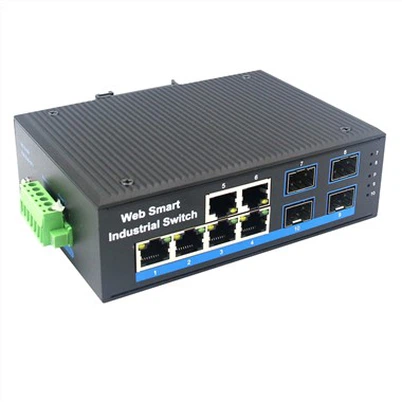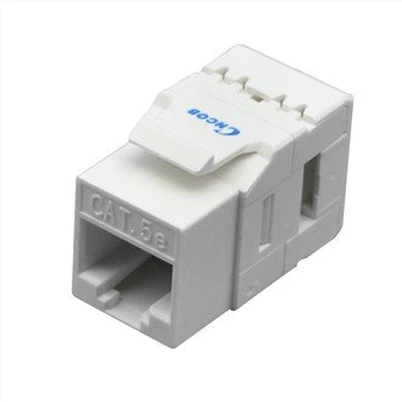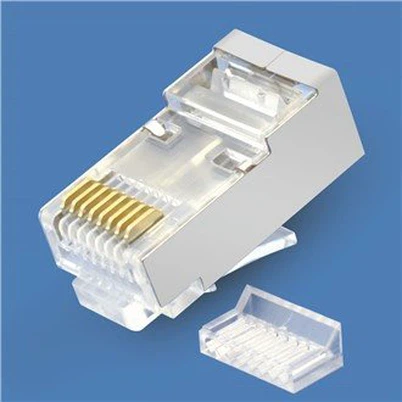Ethernet Cable vs Fiber Optic
Feb 14, 2025
Leave a message
In the evolving landscape of networking technology, understanding the key differences between Ethernet cables and fiber optics is essential for making informed decisions. This blog provides an in-depth comparison of "Ethernet Cables vs Fiber Optic," highlighting their unique characteristics, performance capabilities, and applications. Ethernet cables, including Cat5e, Cat6, Cat7 and the advanced Cat8, are cost-effective solutions widely used in home networks, data centers, and industrial setups. On the other hand, fiber optic cables, featuring multimode and single-mode designs, excel in long-distance, high-speed data transmission with minimal interference. While Ethernet cables are ideal for short-range connectivity and Power over Ethernet (PoE) systems, fiber optics are unmatched in bandwidth and reliability over extensive distances. By exploring the technical distinctions, transmission speeds, and cost considerations, this comprehensive guide sheds light on the ongoing "Ethernet Cables vs Fiber Optic" debate, empowering readers to choose the optimal solution for their networking needs. Whether prioritizing affordability or future-proofing with high-speed fiber networks, understanding the trade-offs between these technologies is crucial as the demand for faster, more reliable connectivity continues to grow.
1. Ethernet Cable vs Fiber Optic:
With the arrival of the 5G era, new applications such as smart cities, intelligent vehicles, virtual reality technology (VR), the Internet of Things (IoT), and telemedicine are continuously driving the development of Ethernet. Ethernet is also advancing toward greater bandwidth, higher speeds, and lower latency. Currently, we are at the 400GbE stage, with the next step being 800GbE, and the ultimate goal set at 1.6TbE. This progress places higher technical requirements and challenges on network transmission media.
Ten years ago, we were talking about "fiber replacing copper," but practical experience has shown that copper cable development is still thriving. For example, Category 8 cables achieve 25GbE and can better support PoE while providing faster speeds. In terms of industrial automation, single-pair Ethernet is also becoming increasingly common and rapidly adopted.
So, what kind of "love-hate relationship" exists between ethernet cables and fiber optics as data transmission media? Let's explore their specific performance characteristics and applications!
2. Overview of ethernet Cables
Ethernet cables, as the name suggests, are cables used for transmitting digital network signals through electrical signals, typically referring to twisted pair cables. Twisted pair is a flexible communication cable consisting of pairs of insulated copper wires and is characterized by its low cost. It is widely used in structured cabling systems, data centers, security monitoring setups, and other scenarios. Common types of twisted pair cables include:
2.1. Category 5e Cable (Cat5e)
Developed by TIA/EIA in 2001, Cat5e cables feature low attenuation and reduced crosstalk with a maximum bandwidth of 100MHz and a maximum transmission speed of 1000Mb/s. Fast Ethernet refers to a speed of 100Mb/s, while Gigabit Ethernet achieves speeds up to 1Gb/s. Cat5e patch cords are suitable for both Fast Ethernet and Gigabit Ethernet applications and are commonly used in home networks or indoor wiring setups. Typically, Cat5e patch cords have a maximum transmission distance of up to 100 meters but perform best within 90 meters.
2.2 Category 6 Cable (Cat6)
Cat6 cables offer a bandwidth of 250MHz and a transmission speed of 1Gb/s. Compared to Cat5e cables, Cat6 features an improved internal structure that includes a cross-shaped separator with tighter twist pitches for the four twisted pairs. This design enhances performance in terms of crosstalk reduction and echo loss mitigation, making Cat6 patch cords significantly better than Cat5e in terms of transmission capabilities. They are ideal for applications requiring speeds above 1Gbps but typically have a maximum transmission distance of no more than 100 meters.
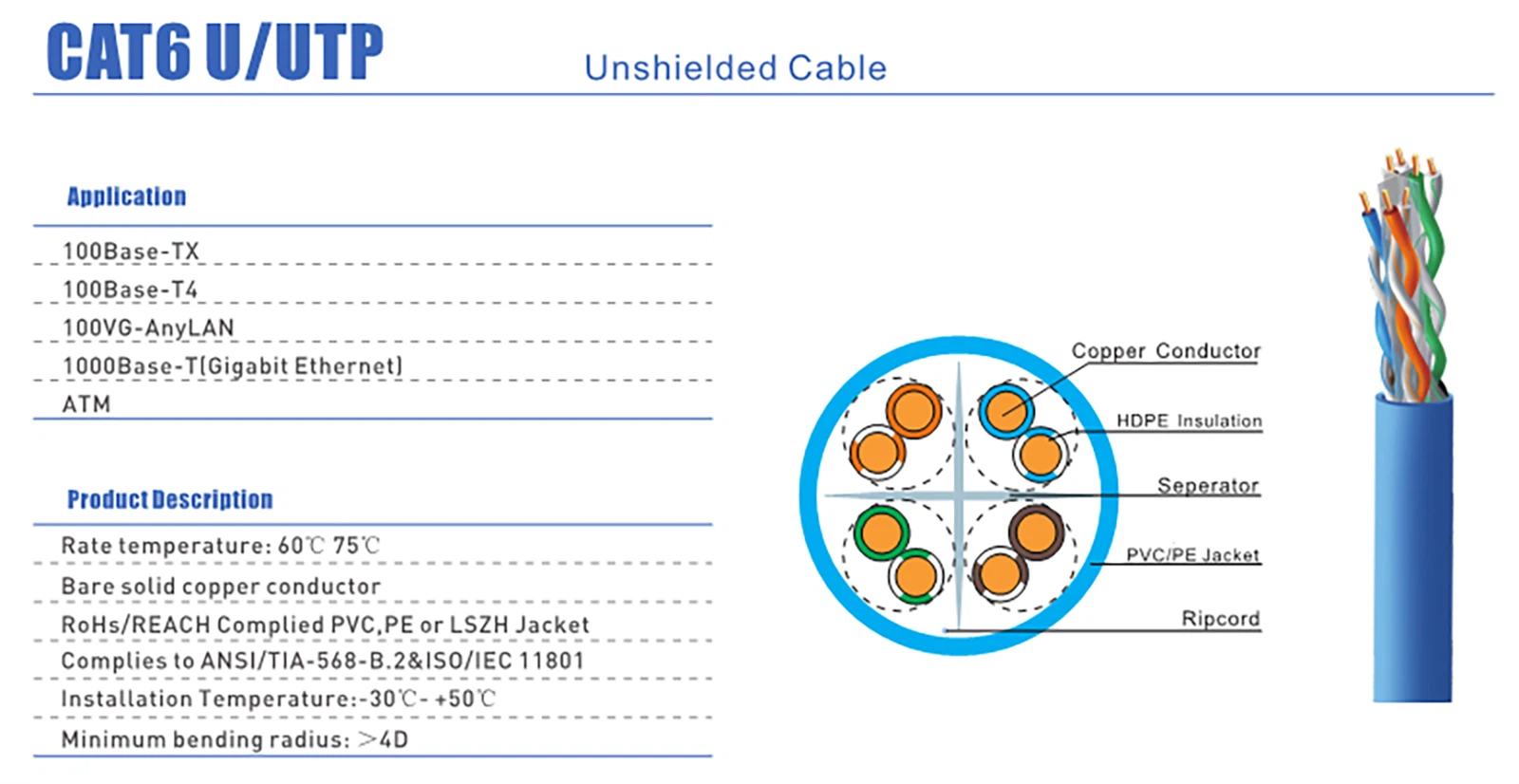

2.3 Category 6a Cable (Cat6a)
With a transmission frequency reaching up to 500MHz and a maximum speed of 10Gb/s, Cat6a patch cords feature superior construction that helps eliminate alien crosstalk (AXT). These cables can support distances up to 120 meters but perform best within 100 meters in terms of signal stability and speed consistency during practical use cases. Additionally, compared to Cat6 cables, Cat6a uses higher-quality conductor materials and insulation materials, making it suitable for server rooms, PoE equipment setups, industrial cabling systems, etc.

2.4 Category 7 Cable (Cat7)
Supporting frequencies up to 600MHz with a maximum speed of 10Gbps within distances under 100 meters, Cat7 patch cords are designed for high-performance Gigabit Ethernet networks. Compared to earlier generations of network patch cords, Cat7 cables offer strong shielding capabilities that effectively reduce signal attenuation, making them suitable for high-density data centers connecting ethernet switches or patch panels. Notably, at distances up to 50 meters, Cat7 can achieve speeds as high as 40Gbps; at distances up to 15 meters, speeds can reach up to 100Gbps. However, due to their lack of flexibility and ease-of-management issues in practical use cases, they have yet to achieve widespread adoption.

2.5 Category 8 Cable (Cat8)
Defined by ANSI/TIA-568-C.2-1 standards as the next-generation twisted-pair copper cable standard, Cat8 cables support bandwidths up to 2000MHz with transmission speeds reaching as high as 40Gb/s but with a limited maximum distance of only 30 meters. Consequently, Cat 8 patch cords are primarily utilized for short-distance connections in data center environments between servers, ethernet switches, patch panels, and other devices. Designed specifically for applications such as 25GBASE-T and 40GBASE-T interconnections between switches and servers in data centers makes them especially well-suited for this purpose.


3. What Are Optical Fibers & Optical Cables?
3.1 Optical Fibers
The terms "optical fiber" and "optical cable" are often used interchangeably. Most optical fibers require several layers of protective structures before use; once covered, they are referred to as optical cables. The protective and insulating layers on the outer surface of the optical fiber shield it from environmental damage caused by water, fire, or electric shock. An optical cable consists of optical fibers, a buffer layer, and a protective covering. Optical fibers resemble coaxial cables but lack the mesh shielding layer. At the center is a glass core through which light propagates.
3.1.1 The Definition of Optical Fiber
The full name of an optical fiber is "optical waveguide fiber," known in English as OPTICAL FIBER.
It is a fiber made from glass or plastic that serves as a medium for transmitting light.
The primary application of optical fibers is in communication.
Currently, communication-grade optical fibers are predominantly quartz-based, with high-purity quartz glass (silicon dioxide, SiO₂) as their main component.
It is a fiber made from glass or plastic that serves as a medium for transmitting light.
The primary application of optical fibers is in communication.
Currently, communication-grade optical fibers are predominantly quartz-based, with high-purity quartz glass (silicon dioxide, SiO₂) as their main component.
3.1.2 Structure of Optical Fiber
Optical fibers are cylindrical in shape and primarily consist of three parts: the core, cladding, and coating layer.
Core: Located at the center of the optical fiber, it is composed of high-purity silicon dioxide with a small amount of doping agents.
Cladding: Surrounding the core, it is also made from high-purity silicon dioxide with minimal doping agents.
Coating Layer: The outermost coating layer is made from acrylate, silicone rubber, or nylon.

3.1.3 Classification of Optical Fibers

There are two common types of optical fibers: multimode fibers (MMF) and single-mode fibers (SMF).
Multimode Fiber (MMF):
Multimode fibers can transmit multiple modes of light; however, they experience significant modal dispersion, which limits their ability to transmit digital signals over long distances. This issue becomes more pronounced with increased distance. Multimode fibers typically have nominal core diameters of 62.5μm or 50μm with an outer cladding diameter of 125μm. Core configurations range across various options such as 2-core, 4-core, 6-core, up to 96-core designs.
Multimode fibers can transmit multiple modes of light; however, they experience significant modal dispersion, which limits their ability to transmit digital signals over long distances. This issue becomes more pronounced with increased distance. Multimode fibers typically have nominal core diameters of 62.5μm or 50μm with an outer cladding diameter of 125μm. Core configurations range across various options such as 2-core, 4-core, 6-core, up to 96-core designs.
Single-Mode Fiber (SMF):
Single-mode fibers transmit only one mode of light, resulting in minimal modal dispersion and making them ideal for long-distance communication. Compared to multimode fibers, single-mode fibers have much thinner cores-approximately 8–10μm in diameter. By carefully designing the refractive index profile and using ultra-pure materials to produce cladding seven times larger than the core diameter, single-mode fibers achieve both minimal loss and minimal dispersion within the wavelength range of 1.3–1.6μm. These fibers are widely used in long-distance and high-capacity communication systems as well as local area networks (LANs) and various types of fiber optic sensors.
Single-mode fibers transmit only one mode of light, resulting in minimal modal dispersion and making them ideal for long-distance communication. Compared to multimode fibers, single-mode fibers have much thinner cores-approximately 8–10μm in diameter. By carefully designing the refractive index profile and using ultra-pure materials to produce cladding seven times larger than the core diameter, single-mode fibers achieve both minimal loss and minimal dispersion within the wavelength range of 1.3–1.6μm. These fibers are widely used in long-distance and high-capacity communication systems as well as local area networks (LANs) and various types of fiber optic sensors.

Differences Between Single-Mode and Multimode Fibers:
Single-mode fibers allow for longer transmission distances, while multimode fibers provide higher bandwidth over shorter distances.
Single-mode fibers do not experience modal dispersion, ensuring more reliable signal quality compared to multimode fibers.
Single-mode typically uses lasers as a light source (more expensive), while multimode often uses less expensive LEDs.
Single-mode cables are generally more expensive than multimode cables.
Multimode cables are cheaper and suitable for short-distance transmissions.

Identification Between Single-Mode and Multimode Fibers:
Single-mode fibers are typically housed in yellow cables, while multimode fibers are commonly found in orange or gray cables. In terms of core size differences: multimode cores measure approximately 50μm or 62.5μm in diameter, whereas single-mode cores measure around 9μm.

3.1.4 Interfaces of Optical Fibers

3.2 Optical Cables?
3.2.1 The Definition of Optical Cables
Optical cables use specialized materials and structures to protect communication-grade optical fibers from mechanical damage and environmental factors while meeting diverse application needs.


3.2.2 Structure of Optical Cables
Optical cables consist of one or more optical fibers or bundles arranged to meet chemical resistance along with mechanical stability under specific environmental conditions.
Regardless of structural type:
Regardless of structural type:
Cable Core: Ensures optimal positioning for stable transmission performance.
Strengthening Element: Withstands external forces during installation.
Sheath: Protects internal components from mechanical stress or environmental damage.
Cable core structures can be divided into two types: single-core designs (filled-core or tube-bundled configurations) and multi-core variants (ribbon-type assemblies or unitary arrangements). Outer sheathing options include metal-armored sheaths for added protection or non-armored ones for lighter applications.
3.2.3 Classification Types:
Ribbon Optical Cables: Primarily used in metropolitan backbone networks that require high-density connectivity with large numbers of cores.

Figure-Eight ("8") Optical Cables: These integrate central elements with steel wire suspension lines directly molded onto PE-jacketed housings-eliminating the need for additional suspension lines during aerial installations, improving efficiency while reducing costs.
Indoor Use Opitcal Cables: Designed explicitly for LAN-building interiors such as vertical cabling solutions within office spaces or residential buildings.
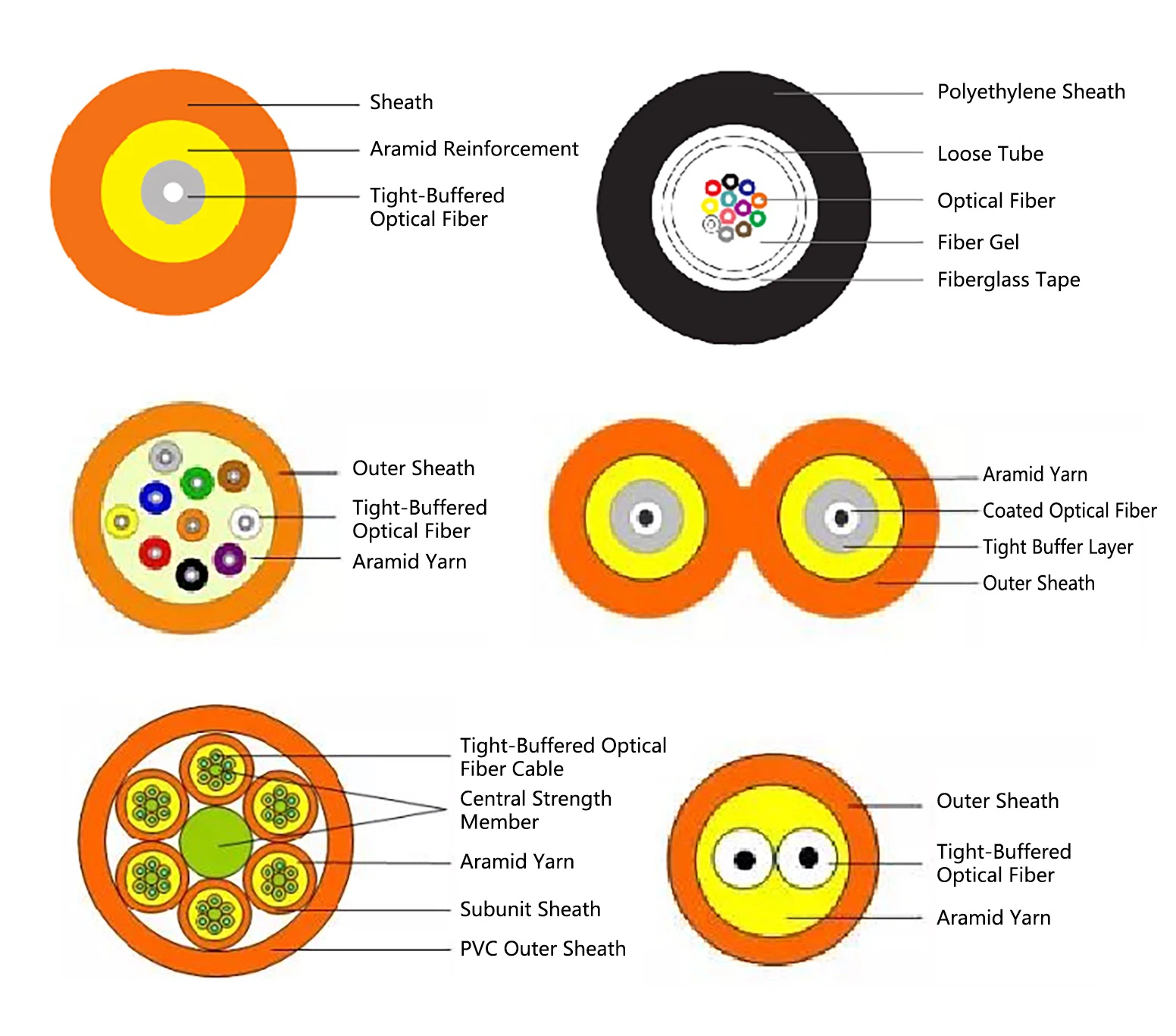
3.3 Features Unique To Optical Fiber/Cable Systems:
Offers high bandwidth capabilities that enable superior data transfer speeds.
Low attenuation rates optimize extended transmission lengths beyond traditional alternatives.
Resistant to lightning strikes and electromagnetic interference.
Provides strong security against eavesdropping or data interception.
Extremely low error rates ensure high reliability.
Compact size and lightweight design make installation easier.
However, challenges include difficulty in splicing connections between segments and higher initial costs compared to legacy copper counterparts.
3.4 Applications:
Backbone transmission networks (e.g., SDH/SONET), including intercity links and undersea submarine cables.
Ethernet applications (e.g., FTTH/FTTB/FTTC), supporting home networks and office setups.
Data storage networks (e.g., Fiber Channel) for databases and emerging cloud computing systems.
Cable TV signal transmission using PIN receivers.
Specialized transmissions such as those required by aircraft or naval vessels.
4. Comparison Between Fiber Optic Cables And ethernet Cables:
4.1 Material Differences:
Fiber optic cables are predominantly made from glass fibers; ethernet cables use copper cables internally.
4.2 Transmission Speed:
While advanced Ethernet cables like Cat8 can achieve speeds up to 40Gbps at frequencies reaching 2000MHz, fiber optic cables remain unmatched with speeds ranging between 40Gbps–100Gbps over long distances.
4.3 Transmission Distance:
Ethernet cables have a limited range of about 100 meters without boosters; The theoretical transmission range of Ethernet cables is restricted to 100 meters, while fiber optics can transmit data over significantly greater distances. Optical fibers can transmit hundreds of kilometers without relay equipment. Thus, ordinary fiber optics can reliably cover several hundred meters without degradation in performance, provided they remain undamaged.
4.4 Cost Considerations:
The production cost of fiber optics is significantly higher than that of Ethernet cables. Additionally, all interfaces compatible with fiber optics require specialized fiber optic connectors. Consequently, deploying fiber optics is substantially more costly than installing Ethernet cables.
4.5 Maintenance Challenges:
Maintenance and Repairs: Fiber-optic cables are more susceptible to damage compared to Ethernet cables. If a fiber-optic cable is pinched or broken during the fiber-to-the-home installation process or regular use, subsequent repairs tend to be much more complex than those of Ethernet cables.

As shown above, both Ethernet cables and fiber optics have their own advantages. Ethernet cables remain essential for applications like voice transmission, indoor networking, horizontal cabling, data centers, security monitoring, and POE systems. Ongoing research and development aim to meet the growing demand for device connectivity in the future. Meanwhile, fiber optic cables are widely used for long-distance, high-capacity, and high-speed signal transmission.


